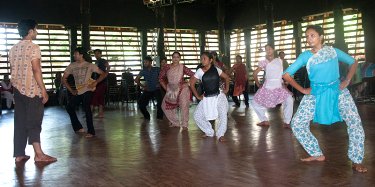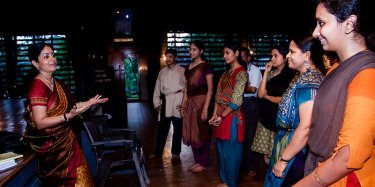
|   |

|   |
Workshop at Rasavikalpam - Dr. Sreedevi N Nampoothiri e-mail: sreedevi.nn@gmail.com Photos: Hareesh N Nampoothiri November 22, 2013 The Kerala Sangeetha Nataka Akademi recently organized dance workshops at different venues in connection with Rasavikalpam, the ten-day long national level dance festival. The workshop at Thiruvananthapuram had sessions in Chhau and Bharatanatyam. 

Chhau workshop
The participants were flying in the air enacting warriors in the first five days as they attended the Mayurbhanj Chhau sessions. The workshop was led by Rakesh Sai Babu, son and disciple of Janmejoy Sai Babu, a pioneer in the art form. He was supported by Sunil Mehra in handling the sessions. The word Chhau is derived from the Sanskrit word chaya and the aim is to reflect the entire nature and its life through precise body manoeuvres. Chhau dance traces its origin to the tribal culture of Orissa. Those days, the purpose of the dance form was to motivate the warriors going to the war field. No wonder, with sword in one hand and shield in the other, Chhau will surely make one think of the other martial art forms. Chhau dancers often appear wearing masks, but in Mayurbhanj Chhau the dancers perform without wearing any masks which makes it unique. A Chhau performer makes use of her/his whole body to express movement, actions and bhavas. Like every other dance, Chhau too has distinct basics which were discussed during the sessions. Chatta (jumps), khura (twists), patla (skywalk) and chamak (shoulder movements) were a few among them. Most of the chatta and khura resembled the movements of animals like tiger, deer, crab, monkey etc. Certain movements resembled the slow motion of village ladies and they were referred to as usli. The walking style mentioned as chali, had six variants. Chhau, as a dance form, has its own lasya and thandava components. Certain movements are reserved for females whereas certain chattas are designed solely for male performers. Good body control, flexibility and balance are greatly required to perform Chhau which can be only acquired through many years of hard work and practice. The participants had the opportunity to understand Chhau and were able to experience it through their body. They were encouraged to push away from their comfort zones slowly and were taught to keep the balance and stability while doing the moves. It was a new way of experiencing one’s own body, its capabilities as well as limitations. Rakesh Sai Babu and Sunil Mehra had success in bringing up this experience, awareness and love for the art form among the participants. 

Bharatanatyam
workshop
The latter days had sessions in Bharatanatyam, which were
handled by Sreelatha Vinod. Moulded in both Thanjavur bani
and Kalakshetra style, her classes proved an eye opener
for the participants. Equal importance was given to the
practical and theoretical aspects of Bharatanatyam.
Samyutha and asamyutha hasta mudras and their practical
usage were discussed. Pada bheda, greeva bheda, shiro
bheda and drishti bheda were demonstrated and the
participants were encouraged to reciprocate. The ancient
traditions and customs which were followed in the past
were also touched upon. The learners were astonished by
the tales of those great artistes, their talents and their
sincere efforts. The evolution of various banis or styles,
the way various ornaments were evolved, the significance
of pushpanjali, all these came in-between the discussions.
The explanation of Narthaki lakshana brought new insight
making the participants wonder whether they fit to the
defined lakshanas.The eight fold classification of Nayikas was also dealt in detail in the workshop. The explanations were based on the way one will react to different situations. The participants were spellbound while they acknowledged the greatness of those artistes who brought even the finest psychological aspects of human mind into the dance form. Bhava and rasa, the structure and form of abhinaya, its interdependence and the way one compliments the other were also discussed. Along with theoretical aspects of Bharatanatyam, participants got the opportunity to learn Mallari (Gambheera Nattai / rupaka), composed by Nellai B Kannan and also “Alarulu Guriyaka....” an Annamacharya composition set in raga Sankarabharanam and adi tala. The technical aspects of both pieces were described, the keerthanam was explained thoroughly and Sreelatha Vinod herself demonstrated these pieces by enacting them gracefully. As an attendee, it is indeed a pleasure to admit that we all had a wonderful time with the gurus and they tried their level best to deliver the maximum within the short span of time. At the end, the workshop turned out to be a meaningful affair, as the participants were able to perceive these dance forms in a different light which of course can be considered as the sole intention of conducting such workshops. Dr. Sreedevi N Nampoothiri is an Ayurvedic physician by profession and an ardent lover of classical art forms. She received basic training in Mohiniattam and Bharatanatyam during her school days and is now pursuing her Mohiniattam under Kalamandalam Shobha. |